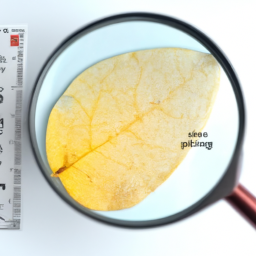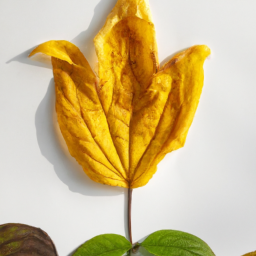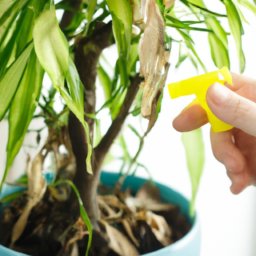
Have you ever noticed yellow leaves on your plants and wondered what could be causing it? Troubleshooting yellow leaves can be a frustrating task for any plant owner, but understanding the causes and finding the right solutions can help you bring your greenery back to life. In this blog post, we will explore the various reasons behind yellow leaves and provide practical tips to address the issue. Whether you are a seasoned gardener or a beginner, this guide will equip you with the knowledge to identify the root cause of yellowing leaves and take appropriate action. So, let’s dive in and unravel the mysteries of troubleshooting yellow leaves: their causes and solutions.
Troubleshooting Yellow Leaves: Causes and Solutions
Common Causes of Yellow Leaves in Plants
Yellow leaves on plants can be a distressing sight for any gardener or plant lover. It is important to understand the underlying causes of this issue in order to effectively address it. In this article, we will explore some of the common causes of yellow leaves in plants and provide step-by-step solutions to help you troubleshoot this problem.
Lack of Sunlight
One of the primary reasons for yellow leaves in plants is a lack of sunlight. Plants need sunlight to carry out photosynthesis, a process essential for their growth and development. When plants do not receive an adequate amount of sunlight, they may exhibit yellowing leaves as a sign of stress.
To address this issue, it is important to ensure that your plants are placed in an area where they can receive sufficient sunlight. If you have indoor plants, consider moving them closer to windows or providing artificial light sources such as grow lights. Outdoor plants should be positioned in areas with appropriate sun exposure for their specific species.
Additionally, be mindful of any obstructions that may be blocking sunlight from reaching your plants, such as nearby trees or buildings. Regularly monitor the amount of sunlight your plants are receiving and make necessary adjustments to prevent yellowing leaves.
Inadequate Watering
Another common cause of yellow leaves in plants is inadequate watering. Both overwatering and underwatering can lead to stress and nutrient imbalances, resulting in yellowing leaves.
To troubleshoot this issue, it is important to understand the watering needs of your specific plants. Some plants prefer consistently moist soil, while others require periods of drying out between waterings. Research the specific requirements of your plants and adjust your watering routine accordingly.
When watering, ensure that you are providing enough water to thoroughly saturate the root zone. This will encourage healthy root growth and prevent water stress. However, be cautious not to overwater, as this can lead to root rot and other issues. Regularly check the moisture level of the soil by inserting your finger into the soil up to the second knuckle. If it feels dry at that depth, it is time to water.
Additionally, consider the drainage capabilities of your pots or planting beds. Poor drainage can lead to waterlogged soil, which can suffocate the roots and cause yellowing leaves. Ensure that excess water can freely drain away from the roots.
Nutrient Deficiencies
Nutrient deficiencies can also contribute to yellow leaves in plants. When plants lack essential nutrients, their growth and development can be negatively impacted, leading to yellowing leaves.
To address nutrient deficiencies, it is important to provide your plants with a balanced and appropriate fertilizer. Different plants have different nutrient requirements, so research the specific needs of your plants and choose a fertilizer accordingly.
Common nutrient deficiencies that can cause yellow leaves include nitrogen, iron, and magnesium deficiencies. Nitrogen deficiency often leads to overall yellowing of older leaves, while iron and magnesium deficiencies can cause yellowing between the veins of younger leaves.
When applying fertilizer, follow the instructions provided and avoid over-fertilization, as this can lead to nutrient imbalances and other issues. Regularly monitor the health of your plants and make adjustments to the fertilizer application as needed.
By understanding and addressing these common causes of yellow leaves in plants, you can help your plants thrive and maintain their vibrant green foliage. Remember to regularly observe and care for your plants, providing them with the necessary sunlight, water, and nutrients they need for optimal growth. Happy gardening!

Identifying Nutrient Deficiencies in Plants
When it comes to troubleshooting yellow leaves on your plants, one of the key factors to consider is nutrient deficiencies. Plants require a balanced diet just like humans do, and when they lack certain essential nutrients, it can manifest in the form of yellowing leaves. In this guide, we will explore the common nutrient deficiencies that can cause yellow leaves and provide you with step-by-step solutions to address these issues.
1. Nitrogen Deficiency
Nitrogen is a vital nutrient for plant growth and is responsible for the lush green color of leaves. When plants lack nitrogen, their leaves may turn pale yellow or even white. Additionally, the lower leaves are usually the first to show signs of deficiency. To troubleshoot nitrogen deficiency:
Step 1: Apply a nitrogen-rich fertilizer to the soil around the affected plants. This will help replenish the nitrogen levels and promote healthy leaf growth.
Step 2: Incorporate organic matter, such as compost or well-rotted manure, into the soil. This will provide a slow-release source of nitrogen for your plants.
Step 3: Ensure proper watering practices. Overwatering can leach nutrients from the soil, including nitrogen. Water your plants deeply but allow the soil to dry out slightly between waterings.
2. Iron Deficiency
Iron is essential for chlorophyll production, which is responsible for the green color in leaves. When plants lack iron, the leaves may turn yellow, with the veins remaining green. To address iron deficiency:
Step 1: Apply an iron chelate or iron sulfate fertilizer to the soil. These products are readily available and can help correct iron deficiencies.
Step 2: Adjust the soil pH if necessary. Iron availability is greatly influenced by soil pH. If your soil is alkaline (pH above 7), it may be beneficial to lower the pH to enhance iron uptake by plants.
Step 3: Avoid overwatering, as excessive moisture can lead to iron deficiency. Ensure proper drainage and water your plants only when the top inch of soil feels dry.
3. Potassium Deficiency
Potassium is essential for overall plant health and plays a vital role in photosynthesis, water regulation, and disease resistance. When plants lack potassium, their older leaves may turn yellow along the edges, eventually progressing towards the center of the leaf. To tackle potassium deficiency:
Step 1: Apply a potassium-rich fertilizer to the soil. Look for fertilizers labeled with a high potassium content or use organic options like wood ash or banana peels.
Step 2: Ensure proper soil drainage. Poorly drained soil can lead to potassium deficiency, as the roots are unable to access the nutrient. Consider improving drainage by adding organic matter or creating raised beds.
Step 3: Monitor and adjust soil pH if necessary. Potassium availability can be affected by soil pH, so it’s important to maintain a pH between 6 and 7 for optimal nutrient uptake.
By identifying and addressing nutrient deficiencies in your plants, you can help restore their health and vibrant green foliage. Remember to closely observe the symptoms exhibited by your plants and take appropriate steps to rectify the deficiencies. With proper care and attention, you’ll soon see your plants thriving with lush, green leaves.

Effective Solutions for Treating Yellow Leaves in Plants
Are you noticing yellow leaves on your plants? Don’t worry, you’re not alone. Yellowing leaves can be a common issue for many plant owners, but the good news is that there are effective solutions to address this problem. In this article, we will discuss the various causes of yellow leaves and provide step-by-step solutions to troubleshoot and treat them.
Identifying the Causes
Before we dive into the solutions, it’s important to understand the underlying causes of yellow leaves. By identifying the root cause, you can effectively address the issue and prevent further damage to your plants.
1. Lack of sunlight: Insufficient sunlight is one of the primary reasons for yellow leaves. Plants need an adequate amount of sunlight to perform photosynthesis, which is essential for their growth and development. If your plants are not receiving enough sunlight, they may exhibit yellowing leaves.
2. Overwatering or underwatering: Both overwatering and underwatering can lead to yellow leaves. Overwatering can cause root rot and hinder the plant’s ability to absorb nutrients, resulting in yellowing leaves. On the other hand, underwatering deprives the plant of necessary moisture, causing stress and yellowing.
3. Nutrient deficiencies: Yellow leaves can also be a sign of nutrient deficiencies. Plants require a balanced supply of essential nutrients, such as nitrogen, phosphorus, and potassium, to thrive. Lack of these nutrients can lead to yellowing leaves and overall poor plant health.
Step-by-Step Solutions
Now that we have identified the potential causes, let’s explore the step-by-step solutions to treat yellow leaves in plants:
1. Adjust sunlight exposure: If your plants are not receiving enough sunlight, consider relocating them to a brighter spot. Place them near a window or in an area that receives adequate sunlight throughout the day. However, ensure that the plants are not exposed to direct sunlight for prolonged periods, as it can scorch the leaves.
2. Proper watering techniques: To address watering-related issues, it’s crucial to find the right balance. Check the moisture level of the soil regularly by inserting your finger about an inch deep. If it feels dry, it’s time to water the plant. However, if it feels moist, hold off on watering. Remember, different plants have different water requirements, so research the specific needs of your plants.
3. Nutrient-rich soil and fertilization: To combat nutrient deficiencies, ensure that your plants are growing in nutrient-rich soil. Use organic compost or well-balanced fertilizers to provide a steady supply of essential nutrients. Regularly fertilize your plants according to their specific requirements. This will help promote healthy growth and prevent yellowing leaves.
4. Pruning and removing affected leaves: If you notice yellow leaves on your plants, it’s important to prune them. Pruning helps redirect the plant’s energy towards healthy growth and prevents the spread of diseases. Use clean pruning shears to remove the affected leaves carefully. Be sure to disinfect the shears between cuts to avoid transferring any potential infections.
5. Pest control: Sometimes, yellow leaves can be a result of pest infestation. Inspect your plants regularly for signs of pests, such as aphids or spider mites. If you identify any pests, use appropriate organic pest control methods to eliminate them. This will help prevent further damage to your plants and promote healthy foliage.
6. Environmental factors: Consider the environmental conditions your plants are exposed to. Extreme temperatures, drafts, or sudden changes in humidity can stress the plants, leading to yellow leaves. Ensure that your plants are placed in a stable environment with suitable temperature and humidity levels.
By following these step-by-step solutions, you can effectively troubleshoot and treat yellow leaves in your plants. Remember to observe your plants closely, make necessary adjustments, and provide them with the care they need. With time and proper care, your plants will regain their vibrant green foliage and thrive in their environment.
Let’s wrap up what we learned
If you’ve noticed yellow leaves on your plants, don’t panic! It’s a common problem that many gardeners face, and there are usually simple solutions to get your plants back on track. Yellow leaves can be caused by a variety of factors, including nutrient deficiencies, overwatering, or pests. By identifying the cause, you can take appropriate steps to restore the health of your plants.
One common cause of yellow leaves is a lack of nutrients, particularly nitrogen. This essential nutrient is responsible for the green color of leaves, so a deficiency can result in yellowing. To fix this, you can use a fertilizer high in nitrogen or add compost to your soil. Overwatering is another culprit, as it can lead to root rot and prevent plants from absorbing nutrients properly. To remedy this, make sure you’re not overwatering your plants and ensure proper drainage. Lastly, pests like aphids or spider mites can also cause yellow leaves. In this case, you can use organic pest control methods or insecticidal soap to eliminate the pests and prevent further damage. By troubleshooting the cause of yellow leaves and taking appropriate action, you can help your plants thrive once again.
Check Out These FAQs:
Q1: Why are the leaves on my plant turning yellow?
A1: Yellow leaves on plants can be caused by various factors. The most common reasons include overwatering, underwatering, nutrient deficiencies, pest infestations, and exposure to extreme temperatures. Identifying the specific cause is crucial in determining the appropriate solution.
Q2: How can I determine if my plant is being overwatered or underwatered?
A2: To determine if your plant is being overwatered, check the soil moisture level by sticking your finger about an inch into the soil. If it feels excessively wet, overwatering may be the issue. On the other hand, if the soil feels dry and crumbly, your plant might be underwatered. Adjusting your watering routine accordingly can help address these problems.
Q3: What nutrient deficiencies can cause yellow leaves?
A3: Several nutrient deficiencies can lead to yellow leaves. Lack of nitrogen often causes general yellowing of older leaves, while insufficient iron can result in yellowing between leaf veins. Yellowing of newer leaves may indicate a lack of magnesium or iron. Using a balanced fertilizer or specific nutrient supplements can help rectify these deficiencies.
Q4: How can I deal with pest infestations causing yellow leaves?
A4: Pest infestations, such as aphids, mites, or whiteflies, can cause yellowing leaves. Inspect your plant regularly for signs of pests, including tiny insects, webs, or discoloration. Depending on the pest, you can use insecticidal soaps, neem oil, or natural predators to control the infestation and prevent further damage.
Q5: What should I do if my plant’s yellow leaves are due to extreme temperatures?
A5: Extreme temperatures, whether too hot or too cold, can stress plants and cause yellowing leaves. If your plant is exposed to excessive heat, move it to a cooler location with indirect sunlight. On the other hand, if it’s exposed to cold drafts, relocate it to a warmer spot. Providing appropriate temperature conditions and avoiding sudden temperature changes can help alleviate the issue.

Lisa Chen is a seasoned indoor gardening expert and the author of several bestselling books on the topic. With a background in horticulture and urban farming, Lisa is dedicated to helping urban dwellers embrace the joys of cultivating green spaces indoors. Her detailed guides and hands-on tips empower readers to transform their living spaces into thriving plant sanctuaries.


